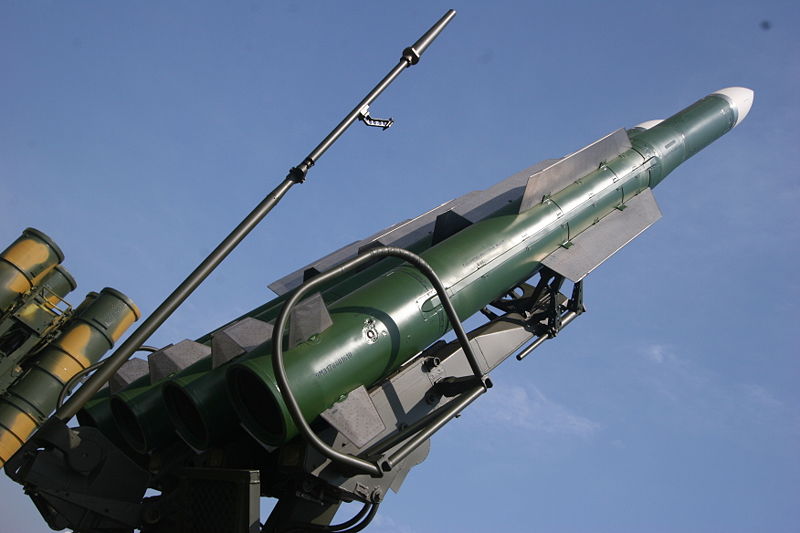The downing of MH17 is another reminder of the vulnerability of civilian aircraft to military weapons. When fired upon by a sophisticated missile system, airliners don’t stand much chance. Weather and collision-avoidance radars won’t give much, if any, warning of an incoming missile (and aren’t designed to) and there aren’t any onboard systems that would allow the aircraft to respond in any case. If the aircraft is in the missile’s engagement envelope—the ‘box’ of airspace the missile’s fuel and manoeuvrability allows it to reach—the outcome isn’t likely to be a happy one.
In short, the only way to keep airliners safe from missiles is to keep them away. For larger surface-to-air missiles (SAMs) of the type likely to have been involved in the recent atrocity, that means keeping a wide berth. A Russian SA-11 (likely last week’s culprit) can reach almost 46,000 ft, which is well above the cruising height of airliners around 30,000 ft.
As the week’s events demonstrated, airliners and tense environments populated by military systems aren’t a good mix. During Cold War tensions, the Soviet air force shot down a Korean airliner in 1983 (and damaged another in 1978) and in 1988 a United States Navy warship shot down an Iranian civilian Airbus on a routine flightpath following a skirmish between surface vessels. If nothing else, the MH17 event might lead to a tightening of the protocols for civilian air traffic over conflict zones—though working against that will be the economics of fuel consumption and ticket prices.
Keeping the aircraft away from the threat by avoiding war zones (or even military exercise areas) is one thing, but a look through the list of historical airliner shoot-down events reveals there’s a risk that the threat comes to the aircraft instead. A number of civilian aircraft have been shot down, and others damaged, by man-portable air defence systems (MANPADS) fired near airfields by irregular groups of militants. Those shoulder-launched missile systems are designed for battlefield use against helicopters and low-flying aircraft and are smaller and more easily concealed than the large SAM systems involved in the incidents described above.
Because their size limits their range and altitude to about 5 km and 10,000 ft respectively, MANPADS don’t pose a threat to commercial aircraft at their cruising altitude. But they represent a real threat to aircraft operating at lower levels, especially at take-off or landing and, in principle, pretty much any airport in the world is vulnerable to attack from these systems. The footprint from which one can be fired against an airliner operating into or out of an airport covers about 800 square kilometers—an impossibly large area to secure. While civilian aircraft have survived hits from MANPADS (such as in this near disaster (video)), a hit on vital systems close to the ground gives the crew little time to respond.
For a terrorist group, those weapons represent an opportunity to prosecute an attack against one of their most preferred targets. The list of attacks shows that they have been used most often by insurgent groups in the Middle East and Africa, and on at least one occasion as part of a coordinated terrorist attack against Israeli civilians in Africa.
The threat to civil aviation from those systems has long been recognised. International efforts to limit their proliferation gained momentum last decade, with the development of the Wassenaar Arrangement for export controls on MANPADS in 2003 and increased regulation and reporting of MANPADS deals. These controls have helped restrict the spread of these weapons, though not before some found their way into the hands of groups such as al-Qaeda (PDF). (It’s not clear that the weapons in the hands of such groups are functional). The Wassenaar Arrangement was designed to keep the weapons safely in state inventories.
But, as Peter Jennings points out, we’re entering a period of history where some states are breaking down and groups of non-state actors such as militant Islamists in Syria and Iraq are perilously close to getting their hands onto the military and industrial inventories of nation states. With MANPADS being in the armouries of over 100 countries around the world, including many of the shakier ones (such as Libya), the possibility of them getting into the hands of extremist groups suddenly looks much more likely.
It’s entirely understandable that Western countries don’t want to get involved in the recent events in places like Syria and Iraq after the experiences of the past decade. But that mightn’t be the right call—the combination of returning fighters and looser control of weapons technologies with the potential to cause significant harm to Western interests and populations requires much greater vigilance. As far as MANPADS go, Australia has the advantage of having no land borders, which takes away the easiest way of smuggling such weapons, but it’s no time for complacency.
Andrew Davies is senior analyst for defence capability and director of research at ASPI. Image courtesy of Wikipedia.


